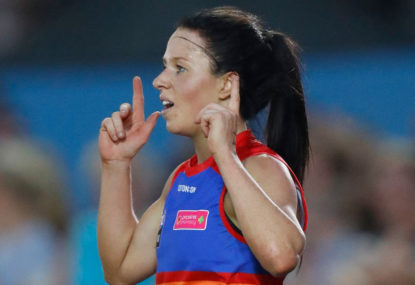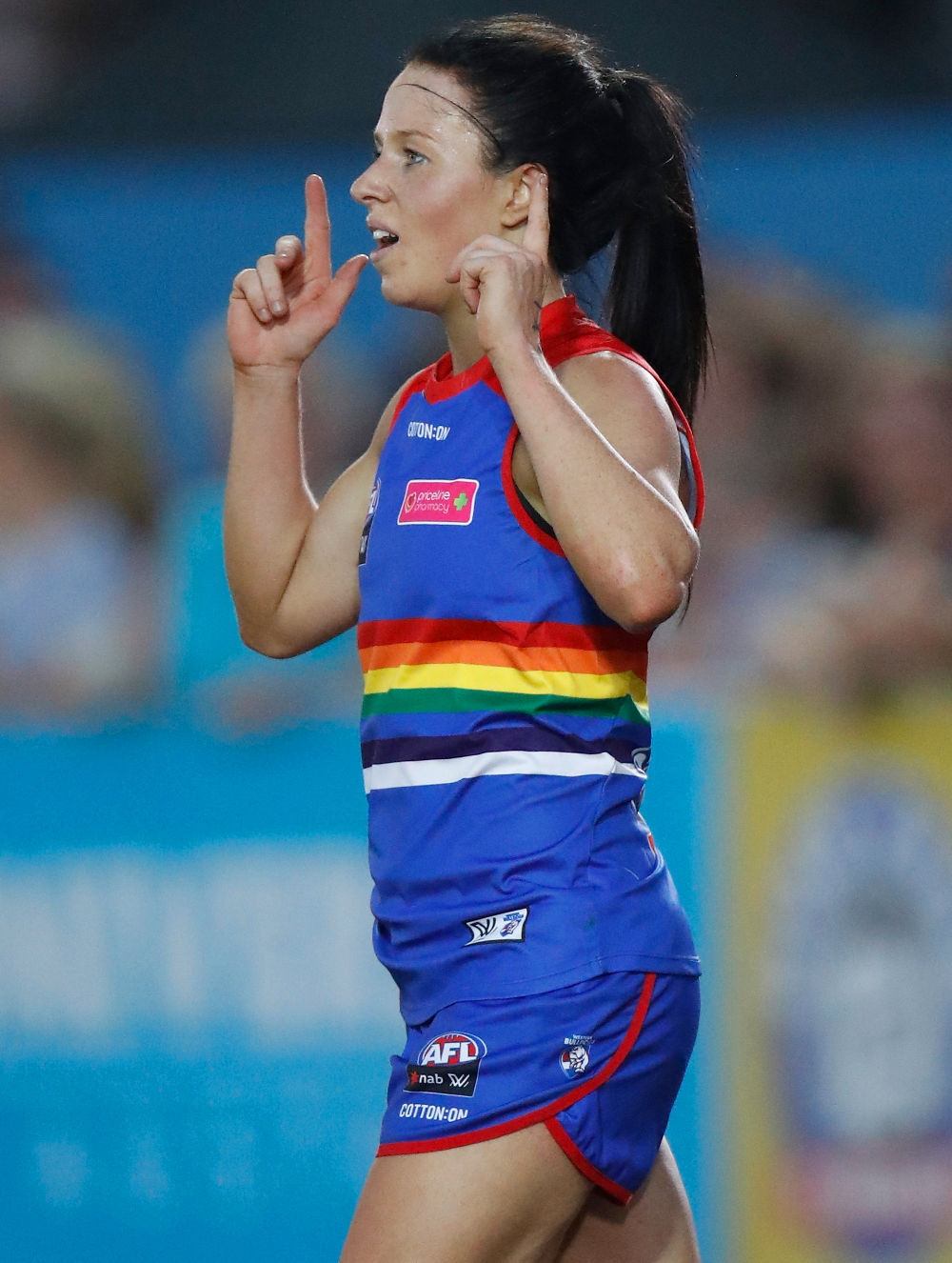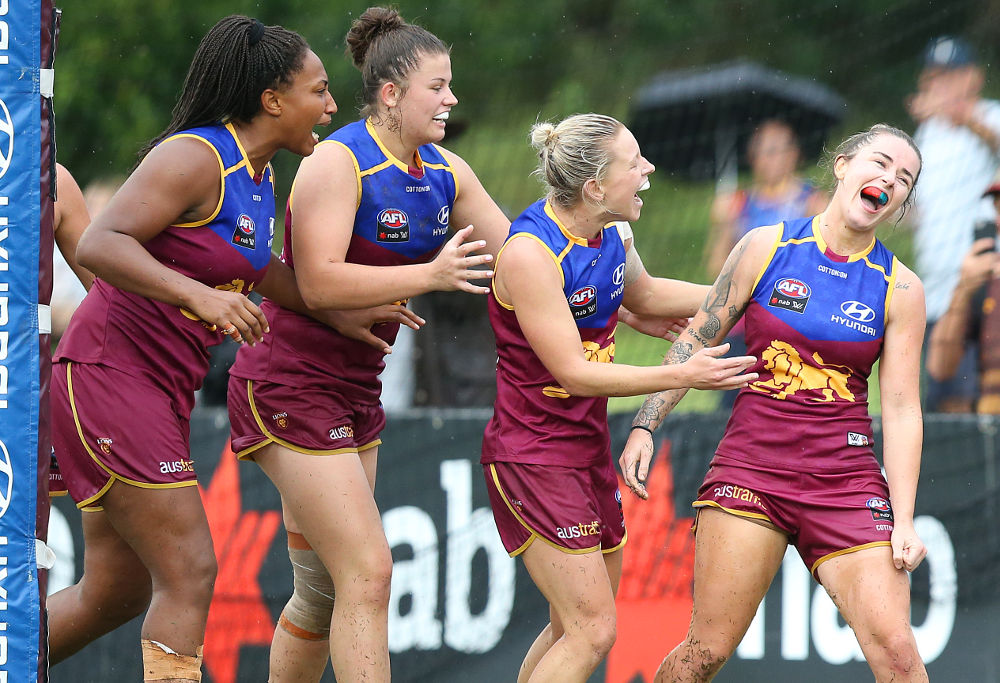Forget Cripps, Curnow and Walsh - the unsung Blues heroes driving Carlton's premiership push
The Blues have truly stood up and are a genuine flag threat in 2024 and they have their younger brigade of troops to thank for it.

Round 4 of the 2018 AFLW season saw records broken and a few surprising results.
Brooke Lochland exemplifies the one thing the AFLW can offer fans that the AFL can’t — to see the regular, almost weekly transformation of formerly ‘OK’ players into transformative ones. Transformative in the sense that by their emergence, they transform the competition.
Lochland still plays with the slightly ragged technique of someone relatively new to the game, but her natural athleticism and coordination give her enough of an edge that it doesn’t matter much.
With Brennan and Huntington out, the Dogs went small with their forward line save for Bonnie Toogood. With the howling wind at Whitten Oval stretching both teams’ depth of structure, Lochland found herself with what for most players would have been a reasonable amount of space, but for a player with her running ability amounted to a wide open paddock.
An AFLW record seven goals were the result, while Toogood added another three. No I don’t think Lochland is the second coming of John Coleman, but her emergence creates a fascinating new wrinkle for opposition coaches to deal with, possibly to the point of taking one of their fastest midfielders or wingers out of the game just to play spare in defence and block Lochland’s run.
On the other hand, maybe those seven goals were more about how each team handled (or didn’t handle) the wind, and won’t happen again on less windy days.
Much has been made of the fact that despite the blowout scoreline, the Dogs only had one more inside-50 than the Blues, and were behind in that stat for much of the game.
Some writers have speculated that it’s somehow the fault of the Blues’ forwards. Well no — playing with the wind, Carlton bombed long and prayed, while the Dogs played their usual game and chipped short, gaining ground while maintaining possession and control.
The Dogs have quite a few midfielders who can kick long, with Kearney (26 possessions), Blackburn (18 possessions) and even Utri (who did a tremendous job in her stints in the middle for such a new player, using her size and power to break tackles and run hard, and gaining 18 possessions) can all kick at least forty meters on a calm day, and with the gale much further.
Suddenly the Dogs had the same possibilities of depth confronting them while moving the ball that men’s teams have on a calm day, and Carlton’s defence got stretched trying to cover all those gaps over the possible 50-plus meters a kick might travel.
Going into the wind… well, the only option is to kick short, but Carlton did a much worse job of guarding the short leadup pass than Adelaide did the previous week, and their midfielders rarely had enough time and space to get clean entries into their own forward-fifty, meaning more poorly-aimed bombs that gave their forwards no chance.
Yes they got the ball forward quite a bit, but the delivery was awful due to the Dogs’ midfield pressure, giving the Bulldogs’ defenders a big advantage — Hannah Scott was again excellent with 16 possessions, and Libby Birch with 8 and a smothering job on Darcy Vescio.
The Bulldogs’ mids have that explosive burst of speed to get clear of stoppage crowds — a skill unmatched even by Melbourne’s mids. Kearney, Blackburn, Conti, even Utri… all can just explode out of traffic, meaning that their next disposal forward is relatively controlled and clear of pressure.
Bri Davey can do the same off halfback, but with her missing, Carlton were always kicking under pressure, and thus all those inside-50 bombs.
The Bulldogs also received 17 free kicks to 7, which despite what Carlton supporters might say is usually not a sign of biased umpiring, but of one team that’s significantly faster than the other, leaving the slower team resorting to desperate and illegal pressure to keep up.
Lastly, I think we’re at the point in the season where we can start nominating the leaders for ‘coach of the year’. There’s a long way to go yet, but at the moment I think Paul Groves is ahead by many lengths.
Of course, it helps that he’s got such good players to carry out his plans, but he can take a lot of credit for that too, working with his staff to shape the Dogs’ list by going so obviously after fast, skilful players through draft and free agency, while other teams chased size and starpower.
Next weekend the Dogs get the Pies, which given the Pies abrupt discovery of previously unseen ballhandling skills could be a real contest.
Carlton get the Crows at Norwood, which given how fast the Crows can move the ball with Phillips, Cramey and Foley back, begins to look structurally quite a lot like this game against the Bulldogs. There won’t be as much wind at Norwood, but unless Carlton find something extra, it won’t be pretty.

(Photo by Michael Willson/AFL Media/Getty Images)
I won’t strain anyone’s credulity by trying to find something interesting to talk about in this match. It was raining so hard it could have been played in scuba gear, and the skills quality would have barely suffered.
Predictably, the Lions were just that little bit more polished in a very unpolished game, and are one of the best teams at throwing numbers around the ball, so they won.
It’s disappointing for the Dockers, who were coming off a good win against Melbourne and were no doubt confident they could have won this match in better conditions. But now we’ll never know.
Most of all, it demonstrates just how much luck plays a part in a seven-game season, and just how badly the competition needs to expand in length, so that total washouts like this one don’t end up defining a team’s season, or playing an outsized role in ending a team’s run for the premiership.
The Dockers deserve better, as Brisbane would have deserved better had they lost, and the fans deserve better most of all.
Special mention here to Brisbane ruck Tahlia Randall, with 33 hitouts in a game dominated by stoppages, helping the Lions to win hit outs 44 to 14.
Kate Lutkins also had 18 in defence, demonstrating why, between her, Kaslar, Koenen and Stanton, the Lions have probably the competition’s best defensive lineup on paper.
For the Dockers, I predicted Lara Filocamo would have a huge game, and she led all Dockers with 18 possessions. Filocamo can be frustrating as her skills are patchy, but when it’s wet and there are bodies to knock over and hard balls to win, she’s a beast.
Kara Donnellan had 15 and 10 tackles, and you have to wonder how things in this game, and their entire season, might have been different were Kiara Bowers present to give them that extra ball-winning midfielder.
Next weekend the Lions get Melbourne — comfortably the match of the round, and once again not covered by Channel Seven, who will be once more covering the league’s least watchable team, Carlton.
Fremantle get GWS, thankfully at home, so at least it probably won’t be raining.

(Photo by Jono Searle/Getty Images)
What kind of a mug would try and predict the football results? I’m glad I don’t do this for a living.
Firstly, there’s never been anything wrong with Collingwood’s physicality and athleticism, the problem’s been their skills. Whatever happened between this week and those previous, the skills suddenly turned up for the Pies, and when combined with their usual athleticism, they looked like a completely different team.
Physicality can transform the way a team plays. Melbourne had more clearances for the game (18 to 15), but even after the first quarter, which they won on the scoreboard, they were behind two to five in clearances.
Then in the second quarter, when the Pies came roaring back, Mick Stinear admitted to Sam Lane that his team were getting outworked in numbers to the ball.
The conditions were very hot in Alice Springs, and the Dees had been on a long roadtrip via Perth, but blaming a lack of effort around the ground on the long trip and the weather doesn’t really work, because Melbourne got flogged at the stoppages in Perth as well when the roadtrip was just starting, and the weather not so infernal.
Even so, Melbourne were still 14 points up to nil at the first quarter break, and doubtless thought this was going to be business as usual — the top team easily beating the cellar dwellers. So what happened?
My best explanation (which could easily be as wrong as previous predictions of Melbourne’s invincibility) is that Melbourne are soft. They know they’re the most talented team in the competition (save perhaps for the Bulldogs), and they started believing their own publicity.
The coaching gameplan reflects this — Melbourne sometimes handballed too much last season, a problem Paul Groves identified with his Bulldogs, and fixed impressively.
In this game the Dees’ kick-to-handball ratio was 1.5, while the Magpies kicked the ball 2.8 times for each handball.
The Demons fiddled, went sideways, looked for ways to skip and dance and finesse their way through the Collingwood defence… and Collingwood were having none of it, and planted them face-down in the turf every time.
Melbourne are as talented as ever, but talent in the AFLW is not a constant — it’s a relative value that goes up or down depending on how much pressure the players are under.
In this game, Melbourne played like a bunch of players who expected their opponents to lie down and get walked all over, much like Carlton did before the Bulldogs the night before.
Possibly that result was even in the back of their minds… and given that Collingwood were currently rated even lower than Carlton, how much threat could they possibly pose to the vaunted Demon midfield?
But the Pies didn’t lie down, they hunted the Melbourne players in packs, put the Demons’ skills under so much pressure that they began to crumble.
Melbourne could have survived if they’d responded in kind, and adopted the hunter’s mindset themselves, picking off Collingwood opponents in hard contests and forcing turnovers, but they didn’t.
And so it falls to the lowest-ranked team in the competition to identify for the rest of the competition exactly what Melbourne’s weakness is.
They’re soft at the contest, soft at the clearances, and their high-skill, high possession game will disintegrate like a sandcastle in the rain if you put enough pressure on it.
Collingwood’s directness in turn rewarded a more open forward line, with Mo Hope (2.3) finally left alone in the goal square where she belongs, with the explosive Sarah D’Arcy back to give an extra threat, and Christina Bernardi having by far her best game of the season with 12 possessions, a goal and lots of set-up work for other forwards.
This meant Jasmine Garner playing down back, where she looked quite comfortable, and gave Collingwood a smaller, faster forward line similar to that used so effectively of late by the Bulldogs.
The downside for Collingwood is that any chance they’ll be taken lightly in the future has vanished, and just in time for them to run into the new flag favourites — the Bulldogs.
Next weekend Melbourne get the Lions, who are a noted hard defensive team, and will be licking their lips at the Dees’ recent vulnerability.

(AAP Image/ Tracey Nearmy)
It was wet, and ended up a draw, so as with Brisbane vs Fremantle, there’s only so much to be learned from a game like this. Wet weather footy is about numbers around the ball, while all previous gameplans go out the window, replaced by hard work, tackling and when nothing’s working try, try, try again.
Both Adelaide and GWS can feel aggrieved at their poor luck in the weather, as both would have relished the chance to back their speed and skills in a fine day, and keep themselves in the finals race. But Sydney weather in summer is what it is, and so we’re left with this.
One thing we’ve learned (again) is that Alicia Eva is a gun. She’s only little, but her workrate and toughness in the contests were formidable, and she finished with 23 possessions (nearly twice as many as anyone else on the field save Angela Foley with 20), eight tackles, and the respect of everyone.
It’s enough to make you wonder if there’s such a thing as size-prejudice among commentators and observers, because if Erin Phillips had played the game Eva played, people would have been crowing ‘MVP!’.
But when Eva does it, she’s the little battler that could, instead of the awe-inspiring leader every young girl wants to play like. And they should, because she’s skilled, fast, tough and one of the smartest players in the competition.
Speaking of Phillips, she had 12 and 4 tackles, but was well held by Peppa Randall and struggled to find her skills in the wet. This might demonstrate just how little practise Phillips has had not just in the past few weeks, but since getting back into football.
Her primary skills are like riding a bike, and she plays on those unforgotten skills most matches, but wet weather skills take practise, and in this game she handled the ball like a cake of soap.
Which reinforces the point made by many — imagine how good she’d be if she’d actually played football non-stop for the last ten years.
Special mention to Ebony Marinoff for breaking the all-time tackling record, men’s or women’s, with 21, made more remarkable by the fact that the women play barely half as many minutes as the men. On the other hand, it’s Marinoff, and in a wet game with lots of stoppage it was always on the cards.
Another encouraging sign for the Crows were young Eloise Jones’ skills in the second half — she finished with ten possessions, but some of her work in the second half made the ball look as though it was dry, fast and precise while everyone else was slipping and sliding. Jones is going to be a player.
Beyond which there’s not really much to say, except that a draw was probably a fitting result, if an anti-climactic one, and both Adelaide and GWS’s seasons are now pretty much out of the championship race.
And it highlights how much it hurts the competition in not having a semi-finals round, because already the Adelaide audience are becoming distracted by the beginning of the JLT series and Bryce Gibbs’ stellar first match, and with the women out of the running, one of the AFLW’s most successful markets will fade with nearly half the season left to play.
If there were a semi-finals round, the Crows women would still be very much in the hunt, and Adelaide crowds would retain their interest for a least a few weeks to come.